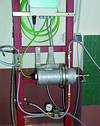
All wastewater plants need measurement to function, whether it is manual or fully automated, for the plant operator to fully optimise and control the plant - information is required. Plant automation is not a nice-to-have anymore, but a necessity and can also prove to be a huge cost saving in the long run.
A typical wastewater plant does not generate revenue - it requires funding. So, the first thing that comes to mind is that we should reduce the operating costs. This can be accomplished by reducing the plant's total cost of ownership (TCO).
TCO is the cost of operating a device or instrument (in relation to automation) over a certain time period or life cycle. In the past, only the unit cost to purchase was considered, but now it is wise to consider cost of the complete measuring point over its total life cycle, or over the life cycle of the specific plant.
* What is the cost to maintain the unit or instrument (calibration, cleaning, etc)?
* Does it justify the initial purchase cost of the device?
* What does it cost to replace the unit?
* What are the effects on the process if the unit fails (plant upsets, etc)?
Three areas that affect the plant TCO are: The measuring point, the control philosophies and the process (microbiological and chemical). By addressing these three points the plant owner can save on chemicals, operating time, maintenance and breakdowns - as well as fines and penalties (by adhering to legislation).
This article takes a look at optimising the measuring point, and how this will save the plant owner on maintenance cost and downtime.
Nitrate measurement on final outflow
Government legislation requires that the nitrate levels on the final effluent of a wastewater plant must not be higher than 1 mg/l. It is not a problem to measure the nitrate. This can be done either manually (using a daily, weekly or monthly sample average) or automatically (using an inline analyser). The problem with the first option (manual) is the time taken to react to deviations. This can result in the imposition of hefty fines and penalties, due to lab results that can take up to 24 hours.
The only option left is inline or continuous nitrate measurement. After a capital investment of approximately R150 000, the plant has its own nitrate analyser on the final outflow (price based on market average and does not reflect any supplier).
Now we need to look at the following variables:
* What is the frequency to clean the unit?
* How long will it take to do this?
* What will it cost on spares for this task?
* What about sample pre-treatment to minimise influences?
* What will operating chemicals (reagents) cost?
If the plant operator/owner starts taking these costs into account over a period of a year, the expense incurred can end up being double the purchase price of the nitrate analyser.
Is the automatic inline measurement of this measuring point worth it? Not in this case. But if we look at the latest trends in online analysis, there is definitely a solution. There is a significant drive by the developers of industrial instrumentation to produce products that can save the user money in the long run. It was this innovative approach that inspired the new online nitrate measuring analyser from Endress+Hauser. The measuring principle of this new nitrate sensor is based on the UV absorption of nitrate.

The water or sludge sample is irradiated by light at a wavelength range of 190 to 2000 nm. The transmission light is diverted by means of an optical system made up of mirrors and lenses, and is guided to a photo receiver. Two sensitive photo receivers are used for the measuring light, which is being weakened in the presence of nitrate. The other photo receivers are used for the reference light, which eliminates interference caused by suspended solids or organic substances.
The in-field calibration feature helps the user adapt the measuring system to the wastewater requirements. This feature gives the plant owner advantages such as a continuous measuring process, no need for sample conditioning, no need for chemicals and the ability to calibrate in the field. These advantages translate to cost savings. See Table 1.

It is easy to see that the inline principle can save the plant owner/operator R31 000 within the first year. It can also be seen that the operational cost of the UV system is much lower than the conventional analyser. (These figures are base assumptions and exclude labour costs and general wear and tear maintenance costs. These figures are illustrative to the operational cost requirement to generate a reading.)
The figures used in the TCO calculation are conservative, but will differ from plant to plant. To get a more accurate account, an individual TCO calculation for each application should be done. But the point is that by improving existing technology the user can save substantial capital. Clearly, simply purchasing the lowest cost unit to save or staying with existing principles or systems is not necessarily the most effective approach.
The next article in this series will look at TCO and control philosophies.
For more information contact Grant Joyce, Endress+Hauser, 011 262 8000, [email protected], www.za.endress.com
| Tel: | +27 11 262 8000 |
| Email: | [email protected] |
| www: | www.endress.com |
| Articles: | More information and articles about Endress+Hauser South Africa |

© Technews Publishing (Pty) Ltd | All Rights Reserved